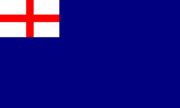Blue Ensign
|
|

1707blue.gif
The Blue Ensign is a flag, one of several British ensigns, used by certain organisations or territories associated with the United Kingdom. It is used either plain, or defaced with a badge or other emblem.
The evolution of the Blue Ensign followed that of the Union Jack. The ensign originated with the St. George's cross (see Flag of England) in the canton and with a blue field background (top right). Red Ensigns denoted commercial colonies established by Royal Charter and supplied by commercial ships while the Blue Ensigns was used by crown colonies supplied by state-owned ships.
The Act of Union of 1707 united Scotland, England and Wales in the Kingdom of Great Britain and produced a new red ensign which utilised the new British flag. With the Act of Union of 1801, Ireland joined the United Kingdom and the St Patrick's Cross was added to the Union Flag of the United Kingdom and, accordingly, to the cantons of the British ensigns.
| Contents |
Plain blue ensign
Prior to the reorganisation of the Royal Navy in 1864, the plain blue ensign had been the ensign of one of three squadrons of the Royal Navy, the "Blue Squadron", which patrolled the Pacific Ocean and the Indian Ocean. The plain blue ensign remains the ensign of the Royal Naval Reserve.
The plain blue ensign is permitted to be flown, instead of the Red Ensign, by two categories of civilian vessel:
- British merchant vessels whose officers and crew include a certain number of retired Royal Navy personnel, or Royal Navy reservists. The number and rank of such crew members required has varied over the years, as have the additional conditions required, since the system was first introduced in 1864. Permission to fly the blue ensign was suspended during both World War I and World War II.
- Vessels belonging to members of certain long-established British Yacht Clubs, all but one of which have "Royal" in their titles.
The law regarding ensigns passed in 1864 allowed free use of the Blue Ensign in these two ways.
Defaced blue ensign
Defaced with a badge or emblem, the blue ensign forms the flag of:
- United Kingdom government departments or public bodies
- Vessels belonging to members of certain British Yacht Clubs
- Most U.K. overseas territories except Bermuda (which uses the Red Ensign) and Gibraltar
- Some members of the Commonwealth, which were in the past British colonies or possessions. All are Commonwealth realms except Fiji, which became a republic in 1987.
The defaced blue ensign was formerly used as:
- The jack of the Royal Canadian Navy from its inception until the adoption of the Maple Leaf flag in 1965. (see Flags of the Royal Canadian Navy 1910-1965 (http://tmg110.tripod.com/canada2.htm)) The blue ensign was approved by the British Admiralty in 1868 for use by ships owned by the Canadian government.
- The official Flag of Quebec until 1948.
Flags of UK Overseas Territories using the Blue Ensign
These include:
- Flag of the British Indian Ocean Territory
- Flag of the British Virgin Islands
- Flag of the Cayman Islands
- Flag of the Falkland Islands
- Flag of Montserrat
- Flag of Pitcairn Islands
- Flag of Saint Helena
- Flag of Turks and Caicos Islands
National flags based on the Blue Ensign
These include:
- Flag of Australia
- Flag of Fiji (light blue)
- Flag of New Zealand
- Flag of Tuvalu (light blue)
See also
External links
Blue Ensign page on the "Flags of the World" website (http://flagspot.net/flags/gb-blenr.html)


